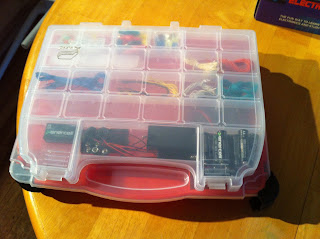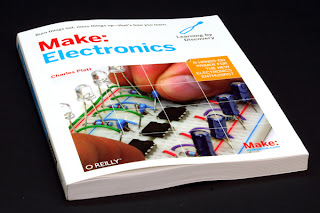So, my little brother (if you recall, of the Bruce Lee level electrical/computer kung fu) indicated in his comment on a previous post that:
"Remember, you always have to put your multimeter in series with the CURRENT you want to measure and in parallel with the VOLTAGE you want to measure. If you try to measure the current by putting your meter in parallel with it, then you have just given current another path to flow and diverted it away from your main circuit (meaning you effectively have no idea how much current is flowing through the circuit in question)."
Of course, his use of the word "remember" implies that at some point in the past I learned the fact in question.
The astute reader may also remember this quote of mine from the first post:
"This does allow for measurement of current but bypasses the switch and closes the circuit. When I did so, I had a current of about 17-18 microAmps. When I pressed the switch, the current dropped to 0.1 microAmps. "
This made no sense to me at the time. Things that don't make sense to me annoy me. Make me stay up at night. But remember, dear reader, the wisdom of Shakira: "hips (and multimeters) don't lie".
When you measure current in parallel, you set up a situation as seen below:
In which the meter becomes a resistor in parallel with whatever is in between the two probes. So it makes intuitive sense to me that the current of electricity--like the current of a river--follows the path of least resistance (but see link). So the ohmic (is that a word?) values of X and the meter dictate what the meter shows. In the situation from the quote above, the measured current of "17-18 microAmps" was with the switch open, and all the current flowing through the meter (as is appropriate). If plugged into the diagram above, x = infinity. Once the switch closed, however, then x = 0.4 ohms (measured), and then it all depends on the resistance of the meter as to where the current flows.
If the current drops by 2 orders of magnitude, then the resistance of the meter must be two orders of magnitude higher, or somewhere around 40 ohms. We will see in a bit that we have some data that indicates it's lower than that, but that still means 90% of the current flows through the switch, not the meter.
So to demonstrate that, I set up the following experiment:
This runs an LED through a protective resistor and then a potentiometer in series. The resistor is designed to protect the LED even if the potentiometer is set at zero. I then measure across the potentiometer and vary the resistance. The above photo has the resistance of the potentiometer set to almost zero (it measures around 1.4 ohms). The fact that we have very little current running through the meter indicates that the resistance of the meter is likely higher than that.
Now we have the same setup, but with the resistance of the potentiometer set as high as it will go, something like 45 kohms. The current running through the multimeter has increased substantially.
Of note the LED did not change intensity at all. Which indicates that this "sharing" back and forth is a zero sum game, as discussed previously.
Here, then, we have an inverse relationship. Flow ~ 1/resistance. What is the total flow through the circuit, then?
To answer that question I had to rewire things. This now bypasses the potentiometer entirely and goes through the switch, where I can put my multimeter in series like I should. So the total flow is 10.88 milliAmps.
Which means that we now have a means of measuring the resistance of my multimeter on this setting. If two resistors are equal, then flow through them should be equal. So if I can adjust the potentiometer to give me 5.44 milliAmps precisely, then it should be exactly the same resistance as the meter, and then we can measure the multimeter directly.
Turns out that's difficult to do.
The potentiometer is quite nonlinear in the range I need. Much fiddling was done, over the course of two days, to try and get close to 5.44. Best I got:
This was the second day, where the measured current across the switch was 10.72 milliAmps. The measured resistance across the potentiometer at that point was:
Which although a little hard to read, is 15.1 ohms. Dividing out the percent of current going through each resistor gives 58.39% of the current through the meter, and 41.6% through the potentiometer. What resistance on the potentiometer will give us exactly 50% flow? That should equal the resistance of the multimeter.
Can't use a straight ratio because this is an inverse relationship. It's (1/15.1) x (1/41.6) = (1/50) x (1/x). Solving for x gives 12.5 ohms.
Not sure if the math is valid but it gave me an answer that makes sense. And much fun was had!
,m
If the current drops by 2 orders of magnitude, then the resistance of the meter must be two orders of magnitude higher, or somewhere around 40 ohms. We will see in a bit that we have some data that indicates it's lower than that, but that still means 90% of the current flows through the switch, not the meter.
So to demonstrate that, I set up the following experiment:
This runs an LED through a protective resistor and then a potentiometer in series. The resistor is designed to protect the LED even if the potentiometer is set at zero. I then measure across the potentiometer and vary the resistance. The above photo has the resistance of the potentiometer set to almost zero (it measures around 1.4 ohms). The fact that we have very little current running through the meter indicates that the resistance of the meter is likely higher than that.
Now we have the same setup, but with the resistance of the potentiometer set as high as it will go, something like 45 kohms. The current running through the multimeter has increased substantially.
Of note the LED did not change intensity at all. Which indicates that this "sharing" back and forth is a zero sum game, as discussed previously.
Here, then, we have an inverse relationship. Flow ~ 1/resistance. What is the total flow through the circuit, then?
To answer that question I had to rewire things. This now bypasses the potentiometer entirely and goes through the switch, where I can put my multimeter in series like I should. So the total flow is 10.88 milliAmps.
Which means that we now have a means of measuring the resistance of my multimeter on this setting. If two resistors are equal, then flow through them should be equal. So if I can adjust the potentiometer to give me 5.44 milliAmps precisely, then it should be exactly the same resistance as the meter, and then we can measure the multimeter directly.
Turns out that's difficult to do.
The potentiometer is quite nonlinear in the range I need. Much fiddling was done, over the course of two days, to try and get close to 5.44. Best I got:
This was the second day, where the measured current across the switch was 10.72 milliAmps. The measured resistance across the potentiometer at that point was:
Which although a little hard to read, is 15.1 ohms. Dividing out the percent of current going through each resistor gives 58.39% of the current through the meter, and 41.6% through the potentiometer. What resistance on the potentiometer will give us exactly 50% flow? That should equal the resistance of the multimeter.
Can't use a straight ratio because this is an inverse relationship. It's (1/15.1) x (1/41.6) = (1/50) x (1/x). Solving for x gives 12.5 ohms.
Not sure if the math is valid but it gave me an answer that makes sense. And much fun was had!
,m









































